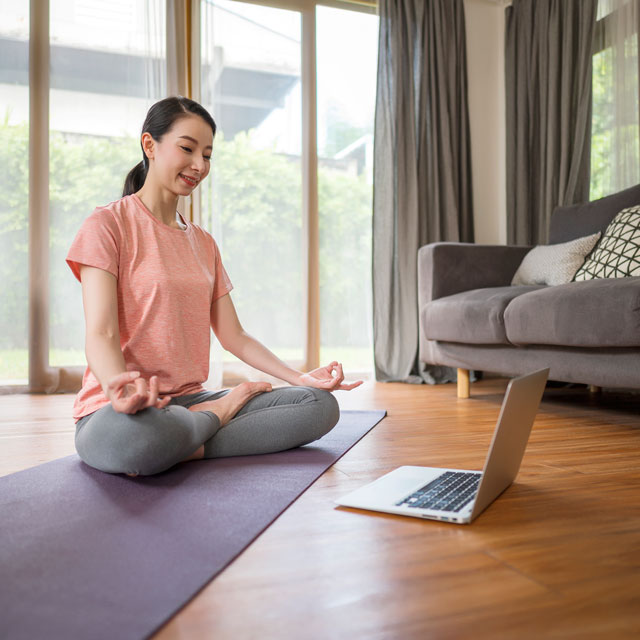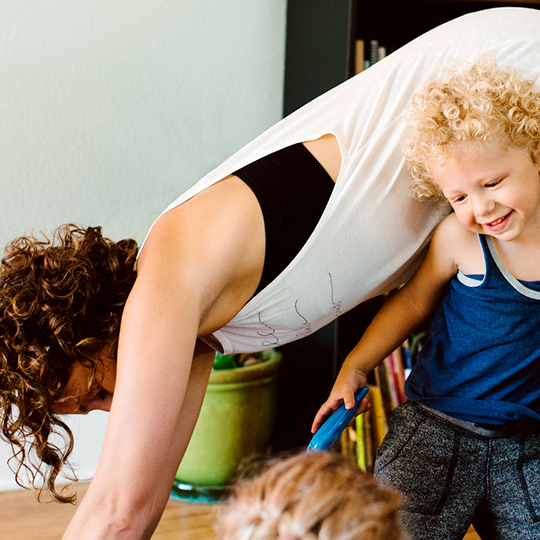Start slowly.
Don’t burn yourself out with high-impact exercise for extended periods of time right away. Gradually become more active by adding a 30- to 60-minute brisk walk to your routine four days a week. Stretch for 15 minutes before and after you walk so you don’t strain your muscles.
Gradually add in more fitness activity.
The American Heart Association recommends that healthy adults get 150 minutes of moderate intensity exercise a week, which equates to 30 minutes, 5 days a week. The good news is that research shows that three 10-minute intervals can be just as effective and much easier to fit into your schedule. Here are a few ways to incorporate these short bursts:
- Commit to always taking the stairs.
- Crank up the music and get your groove on while cleaning or doing dishes.
- Pace while on the phone. If you work for long periods at your desk, consider a standing desk or a walking pad.
- Plan an active meet-up with a friend — a walk, a hike or an exercise class — instead of meeting for dinner or a drink.
- Try using a fitness app to track activity and increase motivation and accountability.
Towards a healthier heart
Don’t overlook strength training.
Strength training isn’t just for body builders, fitness buffs or gym regulars. All adults should engage in workouts that strengthen all major muscle groups at least twice a week, according to the American Heart Association. The benefits of strength training include stronger muscles, a leaner physique, a speedier metabolism, protection from injuries, relief from pain, improved posture and more.
Common strength exercises include lifting weights of about 1 to 2 pounds; using resistance bands; or doing bodyweight exercises, such as sit-ups and assisted squats. Focus on controlled movements and avoid holding your breath, which can lead to lightheadedness. Start with light weights or resistance and gradually increase as strength improves, aiming for two to three days per week. A physical therapist can help you design an individual program to fit your personal circumstances.
Explore more about Fitness

6 styles of yoga to try: How to choose the right type if you’re a beginner

Exercises to do throughout the lifespan for falls prevention

10 surprising benefits of walking
Create a fitness schedule.
Because it’s often difficult to find time to be active, block out time on your calendar as you would any other meeting or event.
Be sure to build variety into your routine and allow adequate time for recovery, especially after weight training. Participating in a unique mix of activities — such as running, yoga and swimming — not only reduces the chances you’ll get bored but also your risk for injury and burnout.
Be sure to stretch.
Stretching exercises improve flexibility, which helps keep a full range of motion in the joints. Flexibility makes daily activities like reaching, bending and turning easier. Better flexibility reduces stiffness that can lead to unsteady movements, thus lowering the risk of falls.
Examples of stretching exercises include gentle neck tilts, shoulder rolls and calf stretches. Yoga is another excellent option, as it combines stretching with balance and body awareness. For safe stretching, remember to move slowly. Never stretch to the point of feeling pain. Stretching can be done every day, ideally after warming up muscles with a bit of light activity.
Build a strong support system.
You’re not in your fitness journey alone! Confidently announce your commitment to becoming more fit to co-workers, family members and friends. Recruit workout buddies to help you stay on track and/or consider joining a fitness-related group to hold you accountable. Online groups count, too! These individuals will help you overcome barriers and encourage you to continue working toward your goals.




